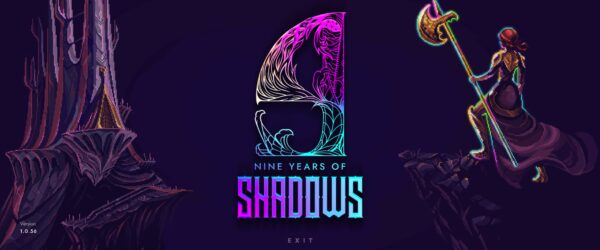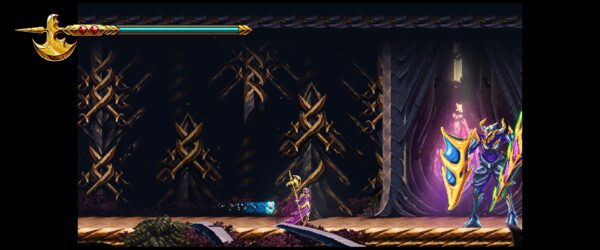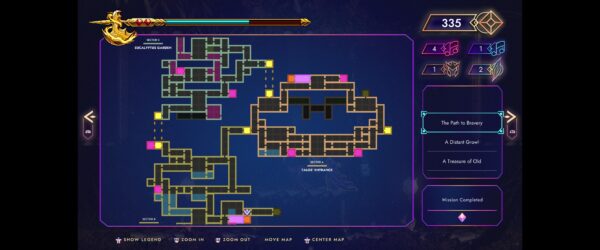There’s a few things a game can do to win me over really quickly and one of those things is fully animated sections, bonus points if that extends to the game itself as well. Such is how I got suckered into giving 9 Years of Shadows a go, it’s trailers brimming with the kind of attention to detail that I love about indie studios who pursue crazy projects like this. It did however remind me of why I didn’t really get into the metroidvania genre until much later in my gaming life: the original titles that spawned its namesake always frustrated me, what with the having to backtrack to unlock new areas, retreading ground to find new places to explore and just generally feeling like a chore past a certain point in the game. That’s where I landed with 9 Years of Shadows unfortunately, putting the game down in frustration as I could not be bothered traipsing backwards and forwards anymore.

The land has been robbed of its colour, drained by a corruption that spreads from a place called. Talos, a dormant fortress where several civilizations have settle over centuries. You are Europa, someone who has lost everything to this curse and now finds themselves duty bound to enter Talos and put an end to the corruption once and for all. The journey will not be easy however as Talos is filled with dangers, some driven mad by the corruption whilst others come from those seeking to find power wherever they can.
The pixel art of 9 Years of Shadows is absolutely top notch, staying true to style whilst bringing in a level of fidelity that’s only possible with a modern implementation. There’s no cheating here with modern lighting effects however, all of it coming from good old fashioned pixel wrangling and layering. As I mentioned before this was what drew me to the game in the first place as both the cut scenes and in-game animations are a fantastic example of what hand crafting these game elements can achieve.

The gameplay is your classic metroidvania, putting you in a whopping great big map to explore that’s gated with various different mechanics that you’ll have to progress through the main story to unlock. There is numerous secrets, optional bosses and other powerups scattered throughout the map that will keep encouraging you to explore as much of every level as you can before moving on. The combat includes some interesting mechanics that put an emphasis on balancing your aggression with your defensive capabilities, with the two at direct competition with one another given their shared resource bar. Mechanically it’s not a particularly deep game, but it is well executed overall.
Combat is pretty straightforward, being mostly a game of playing dodge-the-telegraphed-moves that these kinds of games are well known for. You effectively have 2 health bars: one a shared resource pool which functions as a kind of shield along with ammunition for your secondary attack and your health pips which are effectively the hits you can take once the shield is gone. You can recharge the shield only when it’s fully depleted, which sometimes pushes you into dicey situations of burning down that last couple percent so you can fill it back up again. Upgrades further on give you a kind of second chance refill if you hit the timing perfectly, something that becomes critical with some of the later boss fights.
Which are definitely the most challenging aspect of the game by far. Whilst it’s 90% figuring out the moveset there’s also an element of knowing when you can absolutely unleash your secondary attack, knowing you’ll have a chance to refill it before the boss starts attacking again. There’s no real out-levelling boss encounters either, as more upgrades just net you a bit more shield, another health pip or potentially a slight increase in damage. Nothing that’s going to change a boss fight from impossible to easy by just having enough upgrades. This doesn’t feel out of place though, given that the upgrades themselves aren’t exactly hard to come across.

What really frustrated me though was the lack of a fast travel system and the lack of save points in critical areas. Early on this isn’t much of an issue as the map is pretty small and traversing from one side to another doesn’t take long. However, later in the game, it can take quite a bit of time to hoof it from one end to another and some levels have enemies that are unfortunately not optional. This becomes especially frustrating as you’re looking for the next area to explore as you have to basically run down all those little sections on the map where there’s a gap that could potentially be an opening to the next biome. Trouble is that most of them aren’t, and so you end up retreading an extreme amount of ground just to keep things moving.
I know this is par for the course for what a metroidvania should be but to me it just wasn’t fun. I’ll admit that part of the frustration was me struggling to figure out where I should go next which, even after looking at a fully explored map a couple times, wasn’t exactly clear to me. The game also isn’t popular enough to have proper walkthroughs done for it and I’m not about to scroll through a multi-hour playthrough to figure out where I should go to next.
It also probably didn’t help that I didn’t really gel with the story much. The minimal dialogue means that most of the characters aren’t really given enough time to develop properly, the detail left up to the reader to fill in for themselves. To be sure I’ve been more tolerant of similarly vague stories in the past but there’s usually been some central theme or character to anchor the whole thing. Europa, in the 4 hours I spent with the game, didn’t have enough for me to latch onto to want to push through the game’s other foibles.

9 Years of Shadows is a beautiful but flawed creation, doing a heck of a lot of things right but missing out on some fundamentals that could’ve made it great. Simple changes like the inclusion of a fast travel system between save points would’ve made my time with it a lot less frustrating, vastly reducing the amount of retreading I’d have to do. The animations, progression system and combat are all solid, and are honestly fertile ground for further work on the IP or another game using the same framework. It’s just for this old salty gamer, one who has delighted in the quality of life improvements that have become standard in the genre over the last couple decades, the frustration of retreading the same ground for the nth time sullied it for me.
Rating: 7.0/10
9 Years of Shadows is available on PC and Nintendo Switch right now for $29.50. Game was played on the PC with a total of 4 hours playtime and 26% of the achievements unlocked.



